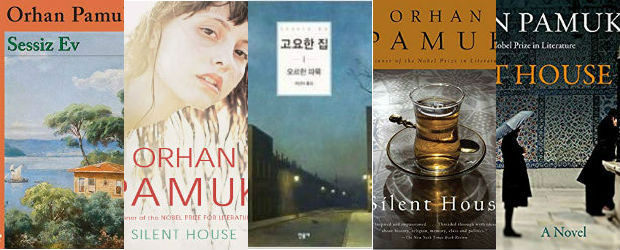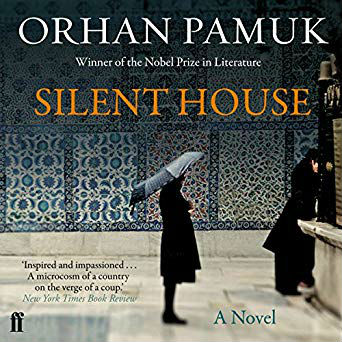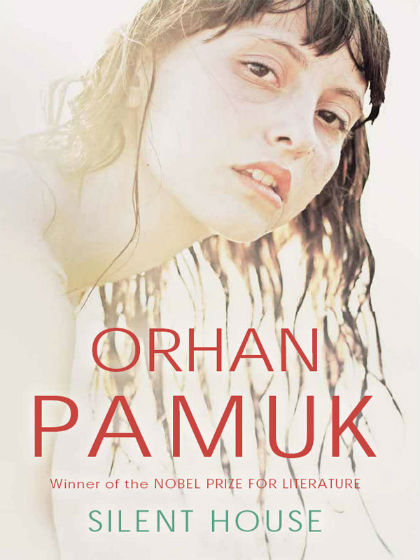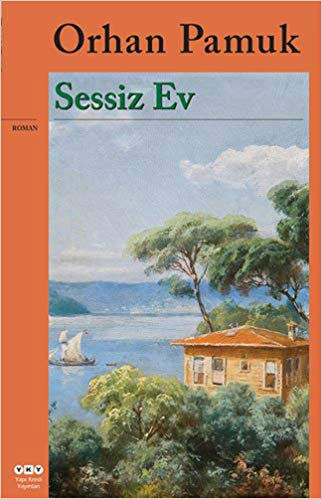In our continual search for new authors we came across the translations of works by Nobel Prize winning Turkish writer Orhan Pamuk and we shared here our views on his 2017 novel – The Red Haired Woman. As you can see in that review, we found a lot to enjoy and admire in his writing and so we have been exploring his earlier works.
Recently, we found an English translation of his second book named Sessiz Ev – “Silent House“.
| Book Title | : | The Silent House |
| Author | : | Orhan Pamuk |
| Publisher | : | Self published; (2019) |
| # of Pages | : |
300 (Hardcover) 352 (Paperback) 1261 KB 352 (Kindle EBook) |
| Purchase Link(s) | : |
|
First published in 1983, this is a book set in a small town of Cennethisar near Istanbul and although the events of the book take place in July 1980, a few months before the military coup of September, the book takes you through to a much longer journey that spans across three generations and a few decades.
In our opinion, the cover page is your first impression of the book and can be very telling… Different versions and editions of the book have different covers, here is a glance to some of them.

Silent House by Orhan Pamuk | Book Covers
Out of all these versions, our favorite is the cover page shows a landscape showing a street filled with old houses with a backdrop of a hill and an old castle-like house on the top of the hill with a flag waving on the top. It is a beautifully, elegant cover that is perfect for this introspective story.
This Is Here In For You
Storyline:
The book makes use of five different narrators to tell the story through their eyes and still keeps the thread alive. These are Recep the dwarf, Grandmother, Hasan, Faruk and Metin.
In the first chapter, we meet Recep as he finishes his daily chores for the mistress of the house and goes out for a breath of fresh air in the night. His mistress lies in the Silent House on the hill and thinks of things old and new as they both wait for the next day that will bring the grandchildren of the house for a summer visit.
The Grandmother – Fatma – was married to Dr Selahattin Bey and had a son with him named Dogan. Dogan had three children, Faruk who is now an associate professor in University, Nilgun, who is a student at the college and leans towards communism and youngest Metin, who is a student in the high school. Dogan’s wife died when the children were still young and they have grown up with their aunt. Dogan took refuge in the silent house for the last few years of his life, but he also followed his wife and his father to an early grave.
Faruk, Nilgun, and Metin come as planned and bring some life to the house. Faruk starts reading and research work in the archives of Gebze, Nilgun enjoys her mornings at the sea and her afternoons around the house, while Metin hangs out with a group of rich kids who have too much money and too little to occupy their time.
Recep is the housekeeper cum caretaker for all of them. He also has a crippled brother Ismail who makes his living by selling lottery tickets. Unknown to the young people, Recep and Ismail are also Selahattin Bey’s sons from their servant. Ismails’ son Hasan is involved with a group of revolutionary boys. Hasan was friends with Nilgun and Metin when they were all children, but now his feelings for Nilgun have become an adolescent crush.

Silent House by Orhan Pamuk | Book Cover
We learn the back-story through mostly Fatma – Grandmother’s musings – in the early 20th century, Dr Selahattin Bey was exiled from Istanbul due to his political inclinations. He and Fatma moved to Cennathisar which was a quiet, seaside village at the time. Due to his anti-religious and scientific notions, he gradually lost his patients. He took up writing of an encyclopedia as the work of his life with an aim to bring all scientific knowledge to the East. This also meant poverty and most of the rest of their lives they had to live by selling Fatma’s jewellery – one piece after another.
Like most women of her time, Fatma was a God-fearing, religious woman who didn’t always understand Selahattin’s denouncement of religion and God. As Selahattin became addicted to alcohol and his life became more lonely, he turned to their servant’s arms, who produced Ismail and Recep. Fatma has never been able to accept these boys as part of the family. All her hopes were centred in Dogan. But Dogan was also not successful in the eyes of the world and never lived upto Fatma’s expectations.
And after all the trouble and sorrows they faced in their lives, it appears that Selahattin’s work was wasted as now Fatma lives in this old, silent house alone, with her memories and her demons, which has never allowed her to bond with Selahattin’s illegitimate children, although Recep is looking after her. The small town of Cennathasir is now a hot, holiday destination and the vineyards and gardens have been replaced with smart villas housing rich people.
Recep has his own troubles trying to find friendship and companionship in this new world full of young people that seem to mock him.
Faruk already sees his life as a failure, Nilgun is at crossroads of where she should lead her thoughts and actions and Metin is desperately looking for an escape from this life – through his dreams of becoming rich and famous and living in America. His sense of failure only intensifies when the girl Ceylan that he thinks he is in love with, doesn’t respond.
Hasan, on the other hand, has always lived in Cennathisar, in a middle-class home, with parents who expect him to do well at school. But like every young man of that time, his head is filled with what is happening in the world. With anti-communism and revolutionary ideas being his only outlet, he is desperate to be seen as a strong young man and fit-in the group.
As the young people try to find their place in this world – Hasan with the revolutionaries, Metin with the rich boys and girls, Nilgun and Faruk with their thoughts – events get out of their hands…just like life has a knack to leave you with nothing but tragedy and sorrows that will keep you company for rest of your existence…
Although it has become a popular trend to use multiple narrators – most of the recent books use two and sagas like Game of Thrones use a few 🙂 – it takes a lot of skill to write the chapters from the point of view of three generations and still turn it into a story that flows effortlessly. Orhan pamuk achieves that here and I think the translator – Robert Finn – also gets the credit for making it a simple and yet effective story. So that you enter this world right from the first chapter and enjoy your journey as you follow the young girl Fatma from late nineteenth century as she lives her life in a country that is struggling with its Eastern identity and the Western influence.

Silent House by Orhan Pamuk | Book Cover
Selahattin represents the young generation from Turkish people who were exposed to Western education, had access to Western ideas and were very keen to bring scientific knowledge to their own countrymen and carve their own niche, even if it led to questioning their religious teachings:
The incredible advances of the sciences in the West had now made God’s existence a ridiculous question to be cast aside; the East’s continued slumber in the deep and despicable darkness of the Middle Ages had not led us, a handful of intellectuals, towards despair, but on the contrary towards a great enthusiasm for work, because what was obvious was that we were not obliged to take all this knowledge and transport it from there to here, but to discover it all over again, to close the gap of centuries between East and West in a shorter time…
Young Selahattin and Fatma represent everything that was fresh and hopeful in a country waking up to new dawn and new world order, or maybe it was just their own youth and the sense of being in a new place, starting a family of their own, with their whole life in front of them, that led to following sentences that are some of my most favourite moments in the book:
Isn’t the world an extraordinary place, those plants, those brave trees that grow up all by themselves it’s impossible not to be amazed by nature, let’s live like Rousseau in the lap of nature and keep far away from those self-proclaimed monarchs and the pashas who suck up to them, let’s examine everything all over again with our own minds. Just to think of all these things is so wonderful…
[ Orhan Pamuk introduces Silent House – uploaded by Faberandfaber at YouTube]
We’ll establish a brand-new world here, thinking and living things that are fresh, simple, happy, and free: a world of freedom such as the East has never seen, a paradise of logic on the face of the earth… with what we have learn from the mistakes of the west and without the Eastern melancholy, the weeping, pessimism, the defeat of our terrible Oriental fatalism…
By the time 1980 has rolled in, the young men and women have none of such optimism left. If they are poor, they are in the mood to rebel, if they are rich, they are too busy trying to amuse themselves and drown their consciousness into nothing. It is so incredibly sad to see the youngsters and see them so lost. It is like they have absorbed the failures of their parents and grandparents and have already lost the battle to start the life afresh. They mock the weakness, are won over by bullies – either by force or by coercion, have fallen into the eternal cycle of complaining how their parents are ruining their lives by asking them to conform to their old-fashioned notions about education.
But above all, the narratives by Hasan and Metin are the cries for help – to be understood, to be loved, to be supported – at this uncertain time of their life. And if they don’t find the help, there is no getting out of the vortex that is sucking them in.
Faruk’s is an occupation that appears very dusty, unproductive and quiet on the surface, but I liked how following observations are woven into his thoughts:
There must be more to history than to linking a string of events together to make a story. May be when looking or the causes of a series of events, we look to other events to compare them with, and those events, in turn, must be explained by comparison with other events still, and on and on until we find that our entire lives wouldn’t suffice to get to the bottom of so many facts.
The true appeal of history is the pleasure of the story, the power to divert us.
Orhan Pamuk’s narrative is so powerful, especially the monologues that show the memory has a way to prove tricks such that at age of ninety, Fatma remembers her childhood and her talks with her husband way more vividly than her present.
It compels you to think, to draw patterns, link dots, travel through Turkey of the twentieth century as it goes through the political changes, world wars and self-regulations. We see the dramatic changes it imposes upon the lives of three generations of the same family and yet how similar their lives become in the end.
And as the author remarks in the very last chapter, we all would like to start over in life at some point or other, but that is not allowed.
This thing we call life, and imagine we have used up, must be such a strange and incomprehensible thing that no one can even know what their own life is. You stand there waiting and on it goes from place to place, no one knows why, and as it goes, you have many thoughts about where it’s been and where it’s headed; then just as you speak these strange thoughts, which aren’t right or wrong, and lead to no conclusion, you look, and journey ends here…
You can’t start out again in life, that’s a carriage ride you only take once, but with a book in your hand, no matter how confusing and perplexing it might be, once you’ve finished it, you can always go back to the beginning; if you like, you can read it through again, in order to figure out what you couldn’t understand before, in order to understand life,,..isn’t that so?
I think the most appealing thing about Pamuk’s writing is how real it feels. As he has remarked in some interviews, “Silent House” was written when he himself was young and so some of the young people in the book are invariably drawn from the young men of Turkey at that time of turmoil and regime change, as he knew them…

Silent House by Orhan Pamuk | Book Cover
Those who went to college in India through the seventies and eighties will relate so easily to the world that is depicted here – the conflicts between Eastern and Western ideologies, the strong influence of communism in the world of that time, the burning fever that only students seem to have to change the world, the desire to not conform…that world is right here in the pages of this book.
Summary:
We loved reading this book and can recommend it to all the readers who enjoy an introspective, thoughtful and serious read with not-so-happy ending…
At least 7.5 stars out of 10.
- Buy Book From Amazon India – Kindle EBook
- Buy Book From Amazon US – Kindle Ebook
- Buy Book From Amazon India – Paperback
- Buy Book From Amazon US – Paperback
- Buy Book From Amazon India – Hardcover
- Buy Book From Amazon US – Hardcover
- Buy Book From Amazon India – Audio Book
- Buy Book From Amazon US – Audio Book
Over To You:
If you already have read the book do share your remarks and thoughts via comments below. Does this review help you in making your decision to buy or read the book? Do not forget to share this article with your friends over various social networks via Twitter, Facebook and others. And yes, you may like to subscribe to our RSS feeds and follow us on various Social networks to get latest updates for the site to land right in your mail box.
 ThinkerViews – Views And Reviews Personal views and reviews for books, magazines, tv serials, movies, websites, technical stuff and more.
ThinkerViews – Views And Reviews Personal views and reviews for books, magazines, tv serials, movies, websites, technical stuff and more.



